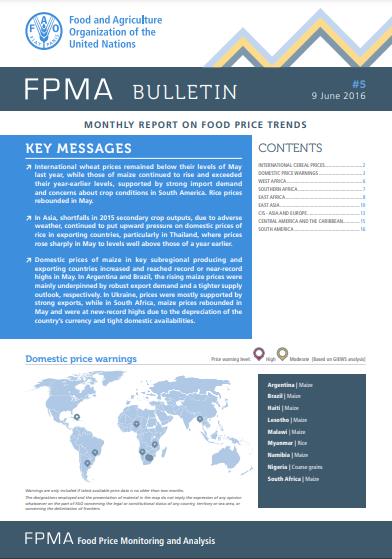
Food Price Monitoring and Analysis (FPMA) Bulletin #5, 9 June 2016
09/06/2016
International wheat prices remained below their levels of May last year, while those of maize continued to rise and exceeded their year‑earlier levels, supported by strong import demand and concerns about crop conditions in South America. Rice prices rebounded in May. In Asia, shortfalls in 2015 secondary crop outputs, due to adverse weather, continued to put upward pressure on domestic prices of rice in exporting countries, particularly in Thailand, where prices rose sharply in May to levels well above those of a year earlier. Domestic prices of maize in key subregional producing and exporting countries increased and reached record or near-record highs in May. In Argentina and Brazil, the rising maize prices were mainly underpinned by robust export demand and a tighter supply outlook, respectively. In Ukraine, prices were mostly supported by strong exports, while in South Africa, maize prices rebounded in May and were at new-record highs due to the depreciation of the country’s currency and tight domestic availabilities.
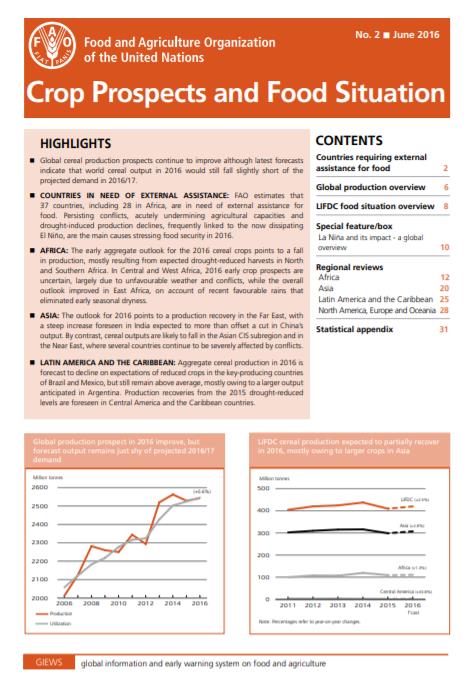
Crop Prospects and Food Situation - Quarterly Global Report, No. 2, June 2016
02/06/2016
Global cereal production prospects continue to improve although latest forecasts indicate that world cereal output in 2016 would still fall slightly short of the projected demand in 2016/17. COUNTRIES IN NEED OF EXTERNAL ASSISTANCE: FAO estimates that 37 countries, including 28 in Africa, are in need of external assistance for food.
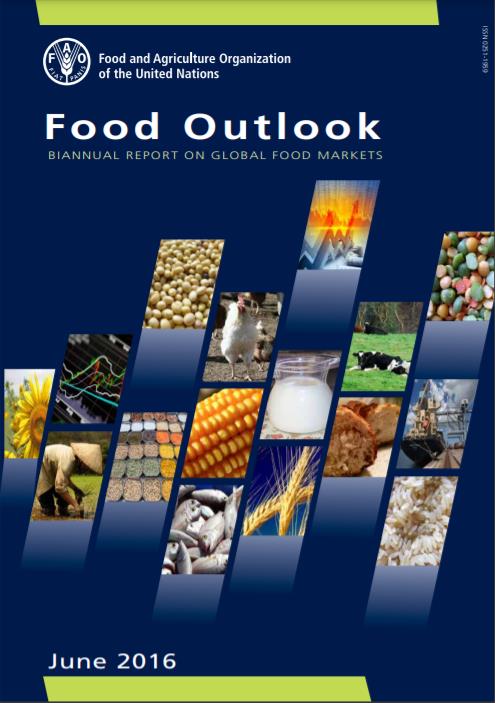
Food Outlook - June 2016
01/06/2016
Global food commodity markets are broadly stable, supported by adequate supplies. Prospects for continued stability remain favourable also for 2016/17. Despite larger volumes of imports, the world food import bill is set to decline by 9 percent to a 7-year low in 2016, on expectation of lower international prices and freights. The International Year of Pulses 2016 presents a unique opportunity to bring to the fore the challenges faced by the sector and galvanize stakeholders to ensure the successful role of pulses in food and nutrition security, poverty alleviation and sustainability.This issue of Food Outlook includes a special features section," Pulses: A multi-faceted crop" that presents information and production, consumption and trade statistics on pulses, the contribution of pulses to environmental sustainability and nutritional benefits of pulses.
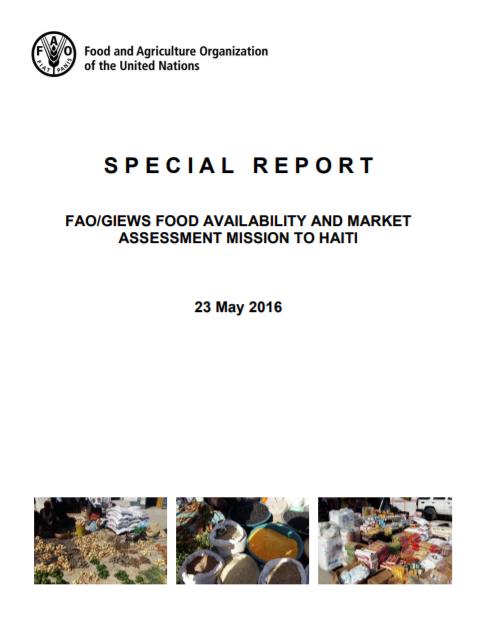
Special Report - FAO/GIEWS Food Availability and Market Assessment Mission to Haiti
23/05/2016
FAO fielded a Mission to the country between 14 February and 2 March 2016 to assess the state of food availability and the stability of markets at the national level. The Mission was composed of FAO, CNSA and the Sub-structure for Agricultural Statistics and Informatics (SSSAI), both agencies of the Ministry of Agriculture of Haiti, Natural Resources and Rural Development (MARNDR). The WFP and Famine Early Warning System also collaborated closely with the Mission.
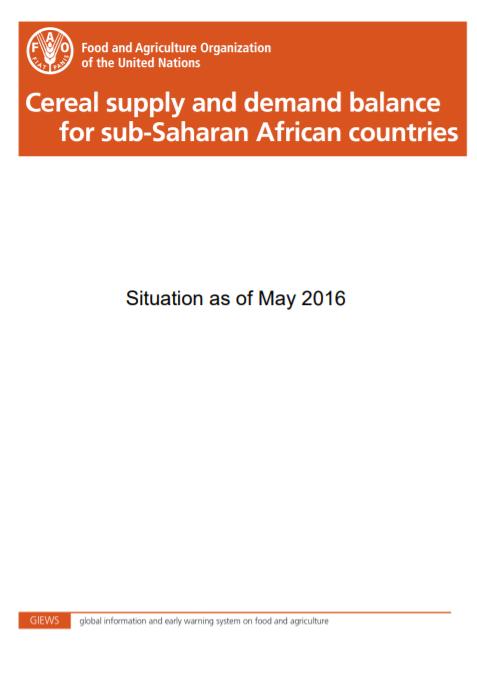
Cereal supply and demand balances for sub-Saharan African countries No.2, June 2016
12/05/2016
This report is based on information available as of May 2016.
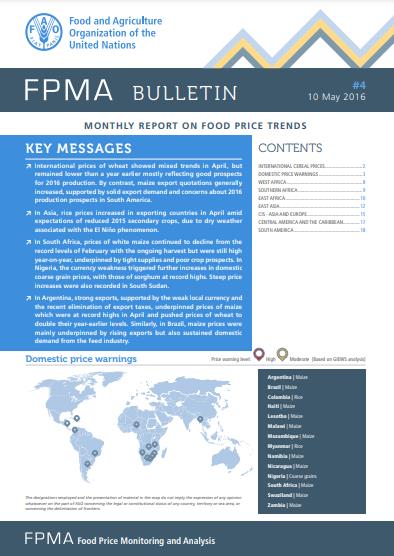
Food Price Monitoring and Analysis (FPMA) Bulletin #4, 10 May 2016
10/05/2016
International prices of wheat showed mixed trends in April, but remained lower than a year earlier mostly reflecting good prospects for 2016 production. By contrast, maize export quotations generally increased, supported by solid export demand and concerns about 2016 production prospects in South America. In Asia, rice prices increased in exporting countries in April amid expectations of reduced 2015 secondary crops, due to dry weather associated with the El Niño phenomenon. In South Africa, prices of white maize continued to decline from the record levels of February with the ongoing harvest but were still high year‑on‑year, underpinned by tight supplies and poor crop prospects. In Nigeria, the currency weakness triggered further increases in domestic coarse grain prices, with those of sorghum at record highs. Steep price increases were also recorded in South Sudan. In Argentina, strong exports, supported by the weak local currency and the recent elimination of export taxes, underpinned prices of maize which were at record highs in April and pushed prices of wheat to double their year-earlier levels. Similarly, in Brazil, maize prices were mainly underpinned by rising exports but also sustained domestic demand from the feed industry.
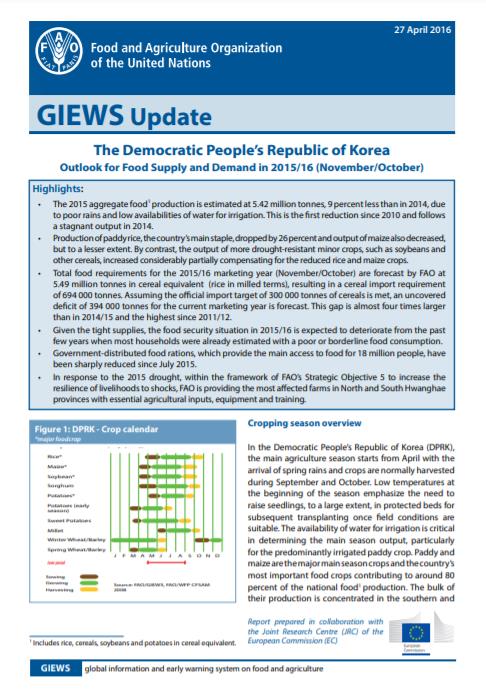
GIEWS Update - The Democratic People’s Republic of Korea, 27 April 2016
27/04/2016
The 2015 aggregate food production is estimated at 5.42 million tonnes, 9 percent less than in 2014, due to poor rains and low availabilities of water for irrigation. This is the first reduction since 2010 and follows a stagnant output in 2014. Production of paddy rice, the country’s main staple, dropped by 26 percent and output of maize also decreased, but to a lesser extent. By contrast, the output of more drought-resistant minor crops, such as soybeans and other cereals, increased considerably partially compensating for the reduced rice and maize crops. Total food requirements for the 2015/16 marketing year November/October) are forecast by FAO at 5.49 million tonnes in cereal equivalent (rice in milled terms), resulting in a cereal import requirement of 694 000 tonnes. Assuming the official import target of 300 000 tonnes of cereals is met, an uncovered deficit of 394 000 tonnes for the current marketing year is forecast. This gap is almost four times larger than in 2014/15 and the highest since 2011/12. Given the tight supplies, the food security situation in 2015/16 is expected to deteriorate from the past few years when most households were already estimated with a poor or borderline food consumption. Government-distributed food rations, which provide the main access to food for 18 million people, have been sharply reduced since July 2015. In response to the 2015 drought, within the framework of FAO’s Strategic Objective 5 to increase the resilience of livelihoods to shocks, FAO is providing the most affected farms in North and South Hwanghae provinces with essential agricultural inputs, equipment and training.
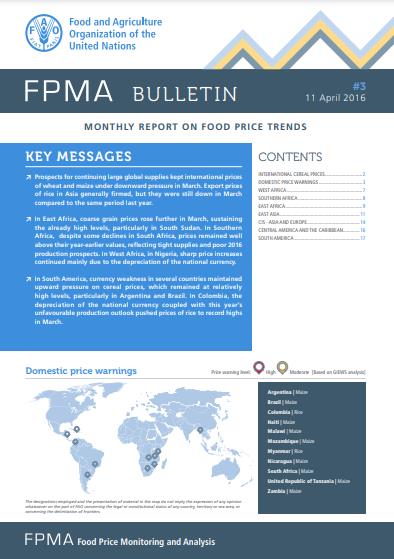
Food Price Monitoring and Analysis (FPMA) Bulletin #3, 11 April 2016
11/04/2016
Prospects for continuing large global supplies kept international prices of wheat and maize under downward pressure in March. Export prices of rice in Asia generally firmed, but they were still down in March compared to the same period last year. In East Africa, coarse grain prices rose further in March, sustaining the already high levels, particularly in South Sudan. In Southern Africa, despite some declines in South Africa, prices remained well above their year-earlier values, reflecting tight supplies and poor 2016 production prospects. In West Africa, in Nigeria, sharp price increases continued mainly due to the depreciation of the national currency. In South America, currency weakness in several countries maintained upward pressure on cereal prices, which remained at relatively high levels, particularly in Argentina and Brazil. In Colombia, the depreciation of the national currency coupled with this year’s unfavourable production outlook pushed prices of rice to record highs in March.
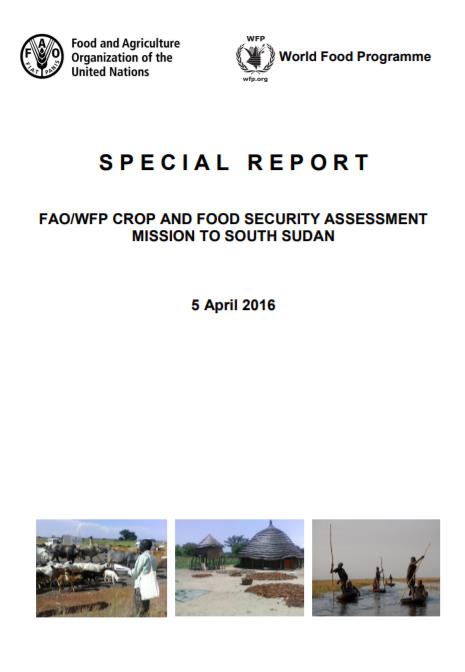
Special Report - FAO/WFP Crop and Food Security Assessment Mission to South Sudan - 5 April 2016
05/04/2016
The Mission estimated the 2015 net cereal production in the traditional sector at about 921 000 tonnes, about 9 percent below the 2014 very good output, but still about 16 percent above the last five-year average production. Despite some dry spells between May and August, seasonal rains in 2015 have been generally abundant and prolonged until December. Major reductions in output have been reported in Western Bahr el Ghazal and Eastern Equatoria states due to unfavourable rainfall as well as in W estern Equatoria State due to the disruption of cropping activities following worsening security conditions. The overall cereal deficit in January-December 2016 marketing year is estimated at about 380 000 tonnes, over 130 000 tonnes higher than the deficit estimated for 2015. About 12 percent of the population was estimated to be severely food insecure at end of 2015, a record level during the harvest period. Food security worsened not only in conflict affected areas of Greater Upper Nile Regi on, but also in other states as a consequence of the economic downturn and skyrocketing prices which limited access to food for most households. In 2016, WFP plans to assist 3 million people providing about 315 000 tonnes of food. Although a large component addresses the needs of people directly affected by conflict in the Greater Upper Nile Region, WFP assistance will also focus on school feeding, nutrition interventions and food for assets programs. The Mission stressed that the achievement o f a stable and lasting peace is paramount in order to progress in terms of agricultural development and improving food security. In order to strengthen local production and reduce the food gap in 2017, FAO’s emergency response will assist over 3 million people with agricultural inputs (often through a system of seed fairs and vouchers) to support planting activities, as well as vegetable and fishing kits, and livestock vaccination/treatment. Moreover, FAO is implementing several resilience build ing programs in the Greater Equatoria and Bahr El Ghazal regions.
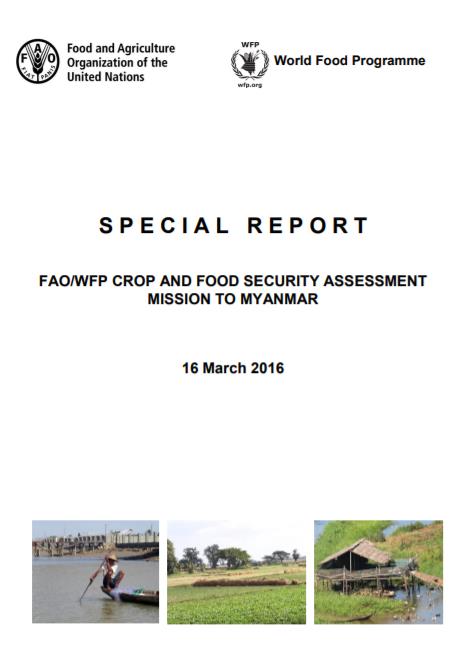
Special Report - FAO/WFP Crop and Food Security Assessment Mission to Myanmar - 16 March 2016
16/03/2016
An FAO/WFP Crop and Food Security Assessment Mission (CFSAM) visited Myanmar from 24 November to 10 December 2015 at the invitation of the Myanmar’s Ministry of Agriculture and Irrigation (MoAI) to forecast the 2015 cereal production (2015 main monsoon and ongoing 2015 secondary summer season) and to evaluate the prospective food security and nutrition situation. The invitation was prompted by the extensive severe flooding caused by heavy rains and the passage of Cyclone Komen at the end of July 2015, which resulted in considerable damage to agricultural land, livestock, fishery/aquaculture and infrastructure. The Mission aimed specifically to assess the impact of the floods on the 2015 main-crop harvest, to ascertain whether there would be a food shortage in the 2015/16 marketing year (October/September) and, if so, to quantify it, and to identify the country’s nutritional and agricultural support needs until the next main harvest. The Mission included three international FAO staff, t hree international WFP staff and a number of national staff from both agencies. The Mission was accompanied for one week by an observer from the European Commission’s Joint Research Centre (EC/JRC).
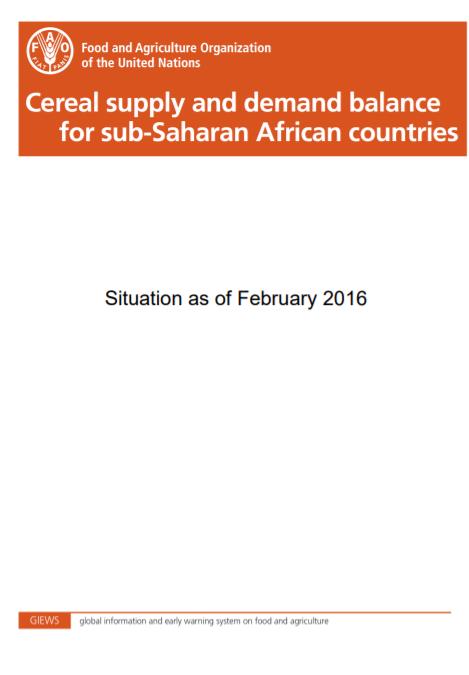
Cereal supply and demand balances for sub-Saharan African countries No.1, March 2016
10/03/2016
This report is based on information available as of February 2016.
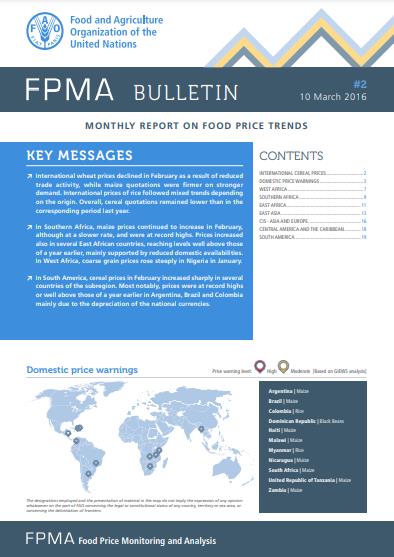
Food Price Monitoring and Analysis (FPMA) Bulletin #2, 10 March 2016
10/03/2016
International wheat prices declined in February as a result of reduced trade activity, while maize quotations were firmer on stronger demand. International prices of rice followed mixed trends depending on the origin. Overall, cereal quotations remained lower than in the corresponding period last year. In Southern Africa, maize prices continued to increase in February, although at a slower rate, and were at record highs. Prices increased also in several East African countries, reaching levels well above those of a year earlier, mainly supported by reduced domestic availabilities. In West Africa, coarse grain prices rose steeply in Nigeria in January. In South America, cereal prices in February increased sharply in several countries of the subregion. Most notably, prices were at record highs or well above those of a year earlier in Argentina, Brazil and Colombia mainly due to the depreciation of the national currencies.
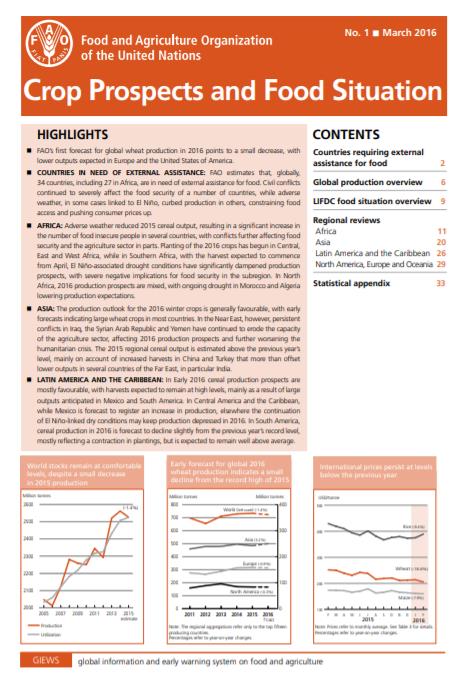
Crop Prospects and Food Situation - Quarterly Global Report, No. 1, March 2016
10/03/2016
FAO’s first forecast for global wheat production in 2016 points to a small decrease, with lower outputs expected in Europe and the United States of America. COUNTRIES IN NEED OF EXTERNAL ASSISTANCE: FAO estimates that, globally, 34 countries, including 27 in Africa, are in need of external assistance for food.
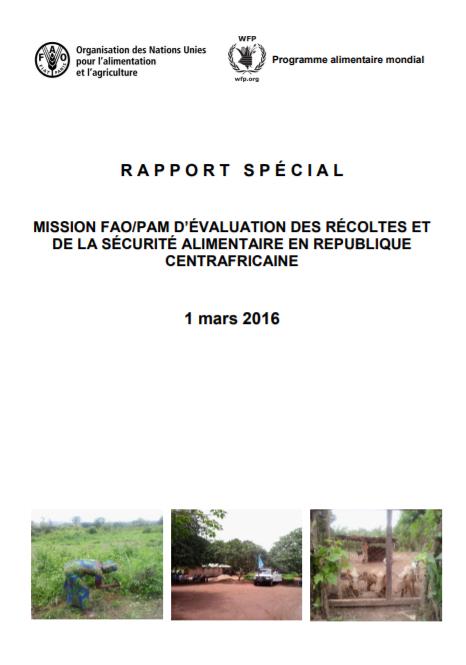
Rapport Spécial - Mission FAO/PAM d'évaluation des récoltes et de la sécurité alimentaire en la Republique centrafriaine
01/03/2016
À la demande du Gouvernement de la République centrafricaine, une mission conjointe FAO/PAM a visité le pays du 26 Octobre au 28 Novembre 2015 pour estimer le niveau des récoltes et évaluer la situation alimentaire générale. En plus du personnel de la FAO et du PAM, les équipes de terrain comprenaient des représentants du Ministère du Développement Rural, du Ministère du plan et de la coopération internationale à travers l’Institut Centrafricain des Statistiques et d’Etudes Economiques et Social es (ICASEES), et de douze (12 ONG) dont quatre (4) ONG internationales (PU-AMI, Solidarités International, COOPI, TGH) et huit (8) nationales (Calebasse, ONFR-FC, GEPAD, GAPAFOT, ARND, Echelle, Kwa Ti Yaka, LIFA).
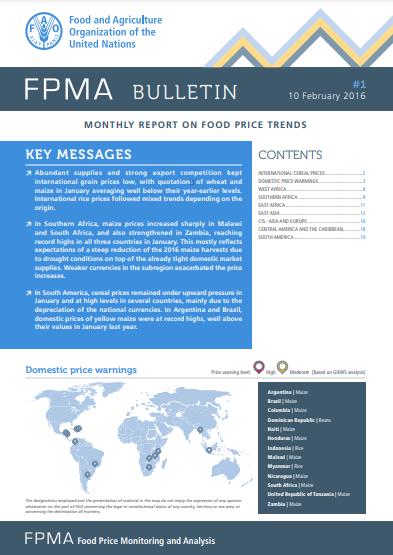
Food Price Monitoring and Analysis (FPMA) Bulletin #1, 10 February 2016
10/02/2016
Abundant supplies and strong export competition kept international grain prices low, with quotations of wheat and maize in January averaging well below their year-earlier levels. International rice prices followed mixed trends depending on the origin. In Southern Africa, maize prices increased sharply in Malawi and South Africa, and also strengthened in Zambia, reaching record highs in all three countries in January. This mostly reflects expectations of a steep reduction of the 2016 maize harvests due to drought conditions on top of the already tight domestic market supplies. Weaker currencies in the subregion exacerbated the price increases. In South America, cereal prices remained under upward pressure in January and at high levels in several countries, mainly due to the depreciation of the national currencies. In Argentina and Brazil, domestic prices of yellow maize were at record highs, well above their values in January last year.
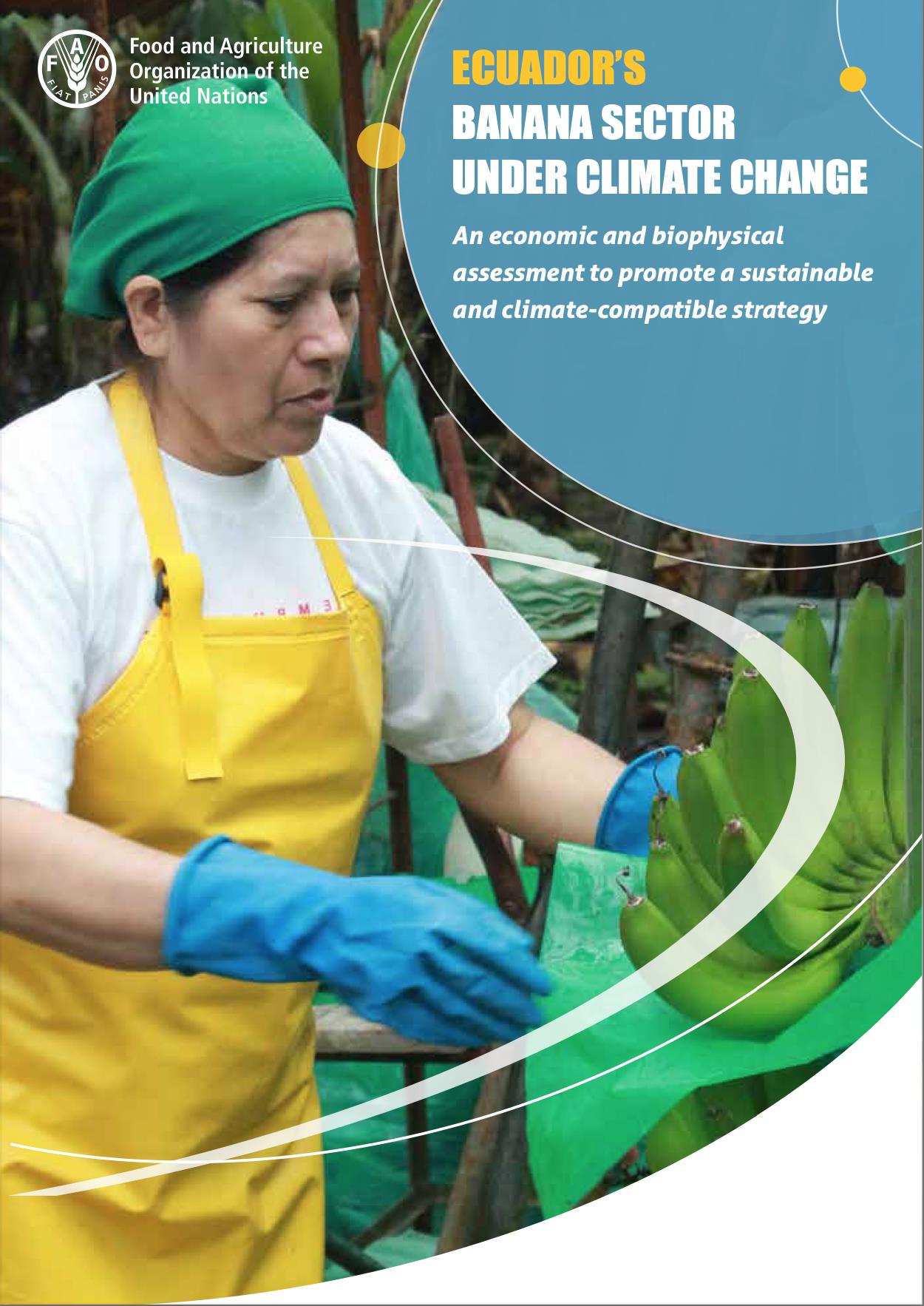
Ecuador’s banana sector under climate change
05/01/2016
At the request of the Ecuadorian Government, FAO undertook a technical assistance to generate an integrated assessment climate impacts on the banana value chain in support of the Ecuador initiatives towards sustainable and climate-adapted strategies. Both biophysical and socio-economic analyses were carried out using a team of FAO and international experts. Evidence was generated on: (i) banana suitability under climate change in Ecuador and other banana producing countries; (ii) climate impacts on yields and potential diseases incidence for bananas in Ecuador; (iii) carbon footprint and greenhouse gas emissions from production to consumption, including transportation and waste disposal. Policy analysis focused on the Government measures aimed at ensuring a fairer distribution of returns between laborers, plantations owners and exporters. The studies were carried between September 2012 and December 2013 and the key findings were presented at a national multi-stakeholder workshop held i n January 2014 in Guayaquil, Ecuador.
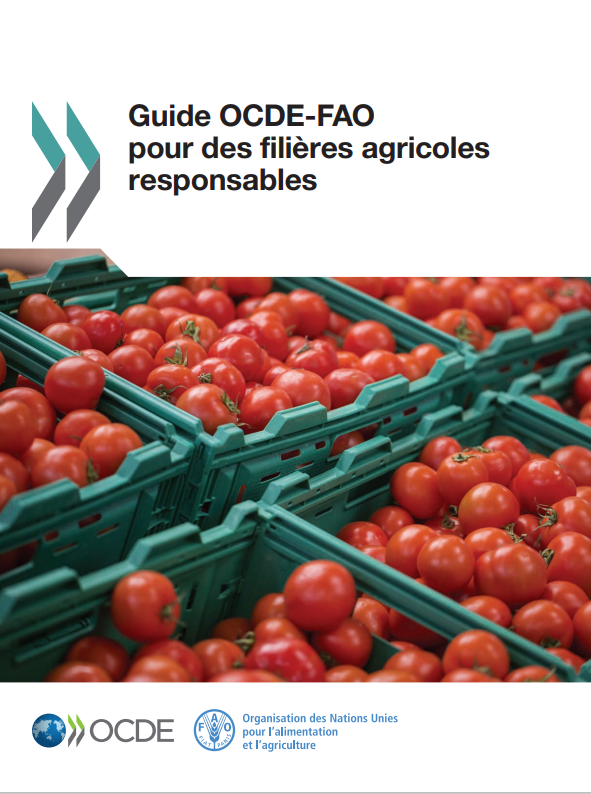
OECD-FAO Guidance for Responsible Agricultural Supply Chains
01/01/2016
FAO and the OECD have jointly developed this practical guidance to help enterprises observe existing standards of responsible business conduct along agricultural supply chains. The guidance is a summary of existing voluntary standards and principles, including the Principles for Responsible Investment in Agriculture and Food Systems (CFS RAI) endorsed by the CFS in 2014. It does not aim to create any new standards, nor does it seek to substitute existing ones.
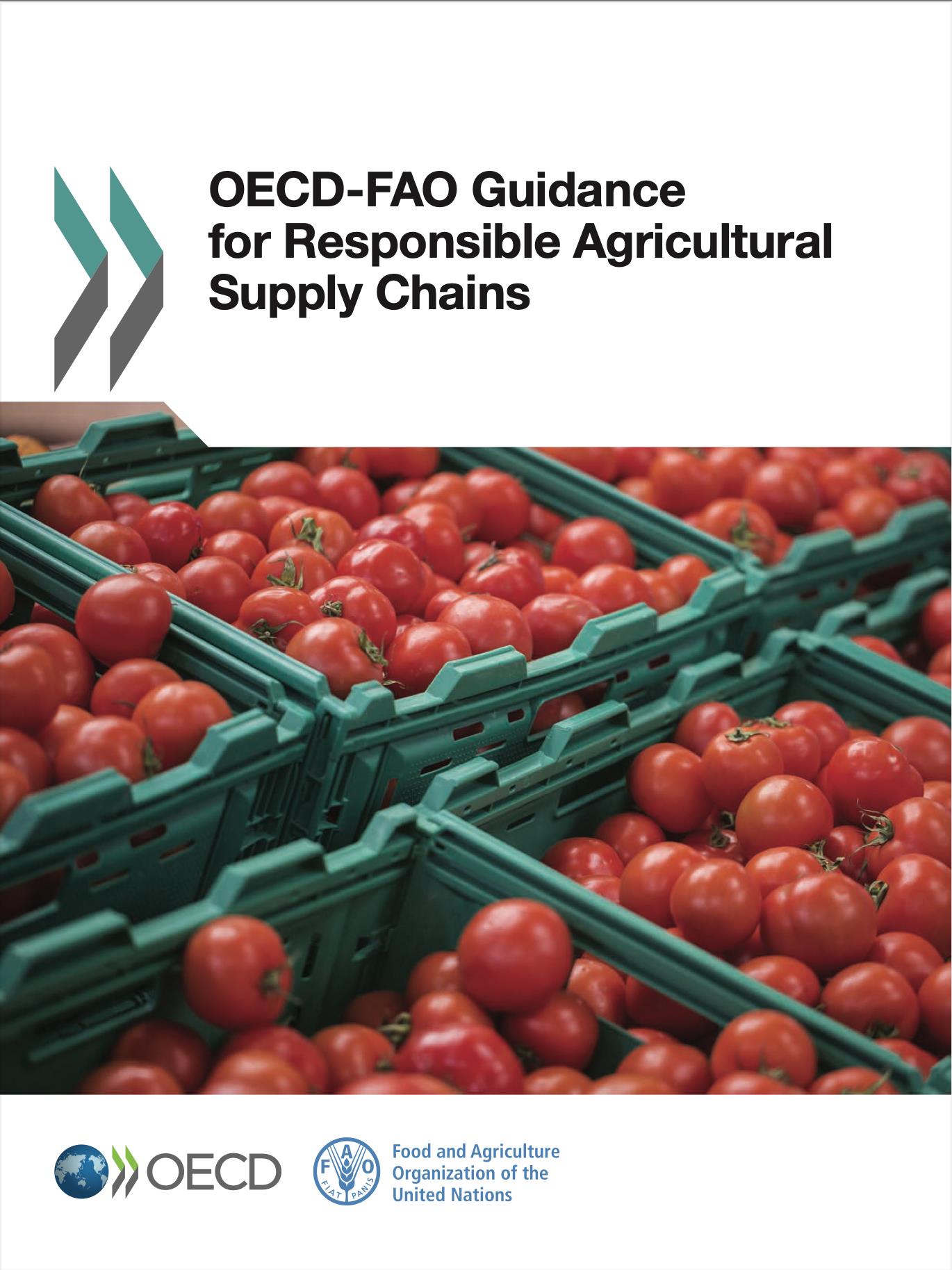
OECD-FAO Guidance for Responsible Agricultural Supply Chains
01/01/2016
FAO and the OECD have jointly developed this practical guidance to help enterprises observe existing standards of responsible business conduct along agricultural supply chains. The guidance is a summary of existing voluntary standards and principles, including the Principles for Responsible Investment in Agriculture and Food Systems (CFS RAI) endorsed by the CFS in 2014. It does not aim to create any new standards, nor does it seek to substitute existing ones. Rather, the guidance aims to help c ompanies implement existing standards by providing recommendations on the steps that they should undertake to identify and address risks of adverse impacts that stem from their activities. This is part of a broader effort of FAO to promote good practices for agricultural investment.
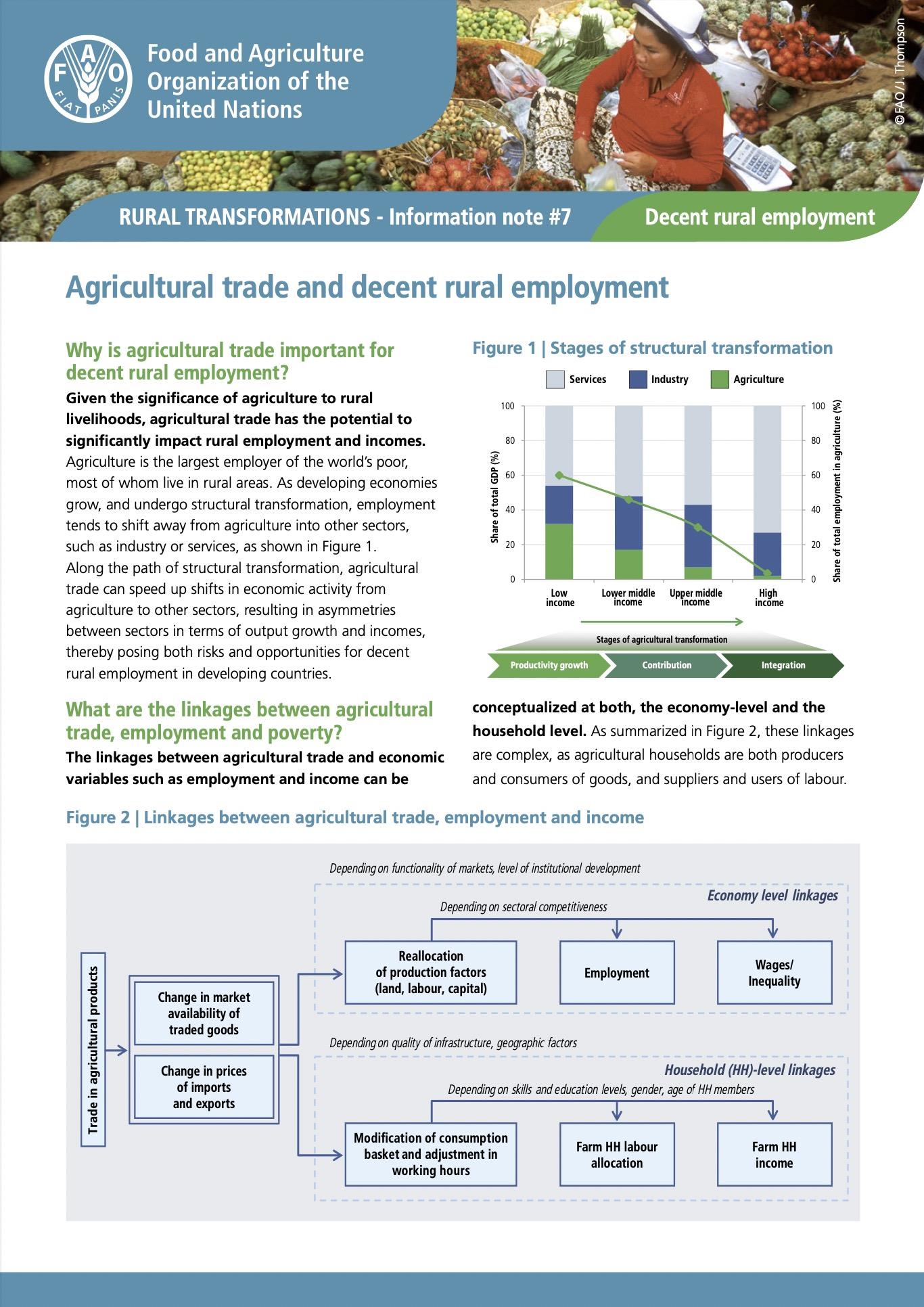
Information Note #7: Agricultural Trade and Decent Rural Employment
01/01/2016
Given the significance of agriculture to rural livelihoods, agricultural trade has the potential to significantly impact rural employment and incomes. Agriculture is the largest employer of the world’s poor, most of whom live in rural areas. As developing economies grow, and undergo structural transformation, employment tends to shift away from agriculture into other sectors, such as industry or services. Along the path of structural transformation, agricultural trade can speed up shifts in econ omic activity from agriculture to other sectors, resulting in asymmetries between sectors in terms of output growth and incomes, thereby posing both risks and opportunities for decent rural employment in developing countries.
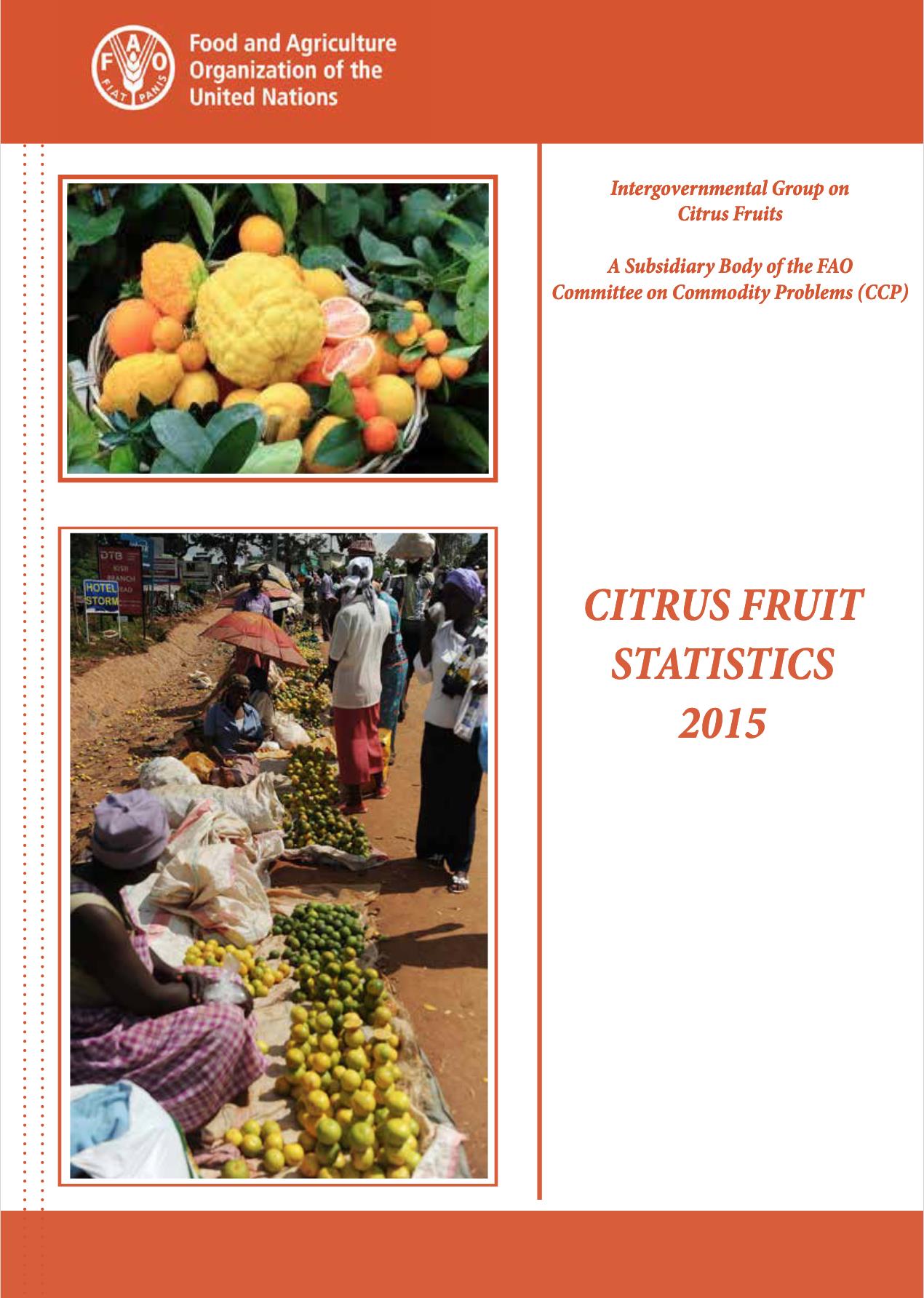
Citrus Fruits Statistics 2015
01/01/2016
This is the 2015 edition of the annual compilation of statistics related to the international production, trade, and processing into juice of citrus fruits with grower and wholesale prices. The fruits covered are oranges, tangerines, lemons, limes and grapefruit. The statistics are disaggregated by fruit, by year, by region and by country from 1981/2 to 2013/14.
